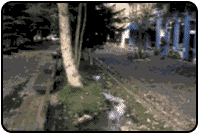Project:
Daylighting Urban Streams in Vancouver
Which stream(s) within the City of Vancouver
would be most suitable to use as an experiment in daylighting urban streams?
Background
Hydrological Concerns
Public Realm Concerns
Summary
Data Sources
References / Acknowledgements
Back to Contents
Background:
"Greening the City"
What is underneath the city? What - or who - was
in your neighbourhood before it was urbanized? What types of inhabitants?
What types of vegetation? I wonder if you can find any "clues" in your
neighbourhood, as to what the climax species would have been? In other
words, what would be growing there, had it not been "re-developed"?
So many of our urban land areas are quite literally
"stamped" overtop of the landscape - so much so that their design (and
their accompanying technologies) have allowed us to continue labouring
under the delusion that "nature" is somehow foreign to our lives, and that
it has become irrelevant. By way of illustration, consider the bumper sticker
"Without nature, you are nothing!" What kind of a society would need
to be reminded of this seemingly obvious reality?
 This issue has caused much recent interest in initiatives aimed at "Greening
the City". This phrase, however, (like all politicized catch-phrases) invites
confusion, as it means different - perhaps conflicting - things to different
people. One thing we forget is that the city was already "green" before
we got here. So, when we speak of "Greening the City", then - what exactly
do we mean?
This issue has caused much recent interest in initiatives aimed at "Greening
the City". This phrase, however, (like all politicized catch-phrases) invites
confusion, as it means different - perhaps conflicting - things to different
people. One thing we forget is that the city was already "green" before
we got here. So, when we speak of "Greening the City", then - what exactly
do we mean?
The traditional response to "greening" has been
to use natural elements to invoke images of "green-ness", images
which may actually be more ecologically damaging. We mow down wildflowers
and plant botanical gardens, and then spray these with toxic chemicals.
We clearcut forests and plant street trees imported from half a world away.
We tear out blackberry bushes and plant ornamental fruit trees that don't
bear fruit.
The reasons for this seemingly ironic approach to
urban ecology may range from human attitudes to legitimate engineering
concerns, bit where does this leave our attempts to "Green the City"?
One recent trend in urban ecology and urban planning
has been the "daylighting" of urban streams. Generally, re-development
has required that formerly free-flowing streams become channels flowing
through underground pipes. For example, it took me by surprise to learn
that the street I live on was actually built overtop of a creek, which
- if still alive - would be trickling sheepishly through an underground
pipe. I was shocked that even my neighbours - some of whom have been here
since our neighbourhood was urbanized - did not know of this.
Our urban design permits us to go on believing in
the (perhaps reassuring) myth that cities (and the human world in general)
exist independantly of ecosystems. This belief has led to numerous ecologically
irresponsible beliefs that are only now being called into question.
Back to Top
Hydrological
Concerns
Another issue highlighting the need for urban stream
restoration is the trouble associated with runoff. Goudie (1993: "The Human
Impact on the Natural Environment") and several others including Ann Riley,
(author of "Restoring Streams in Cities", 1999) note the hydrological problems
caused by conventional urbanization and its traditionally impermeable surfacing.
Think of your neighbourhood. How much of the surfacing is impermeable (eg.
concrete, asphalt, etc)? When it rains, how many materials are washed away
into storm sewers? We map land use, but rarely do we map land cover,
which, from a hydrological point of view, is far more important.
When we were in elementary school, our teachers taught
us about the "Water Cycle". Under natural circumstances, rain would fall
on a wooded or vegetated area, and slowly seep into the ground.
Flowing as groundwater (or, in extreme conditions, as overland flow), water
would slowly spring up and contribute to streamflow over a long
period of time. This moistens the soil, and ensures a relatively constant
flow of streamwater over time, ensuring that plants and animals get the
moisture they need, and helping to maintain a diverse, healthy ecosystem.
Unfortunately, impermeable surfacing interrupts
the water cycle at its most crucial point: the interface between rainfall
and vegetation. It seems ironic that in Vancouver, a city known for its
mild and rainy climate, we have built a city on the assumption that it
does
not rain - so much so that during our winter rainstorms, our storm
sewers exceed capacity, causing raw sewage to spill over into the Strait
of Georgia, yet in the summer dry spell, they sit empty!
As in most cases, we are unsuccessfully trying to
replicate a service that nature provides for free: the management of stormwater.
And, as in most cases, nature does it better.
Even in a rainforest city like Vancouver, conventional
urban development generally views rainwater as a "nuisance" that must be
removed from the site as quickly as possible, hence the construction of
the storm drains and expensive piping infrastructure mentioned above. This
means that rainwater is moved very quickly through the system and
out to sea, leading to an increase in the "extremities" of the flood
hydrograph (i.e. streams will either be overflowing, or almost completely
dry) Not only does this destabilize local ecological systems, but (from
a human perspective), but our current attitude toward drainage also causes
serious property damage due to flood erosion, and also (as alluded to above)
required expensive and often redundant infrastructure. Consider that during
the summer dry spell, storm drains simply "sit there costing money", whereas
during the winter storm season, they are operating over capacity!
Back to Top
Public
Realm Concerns
The
daylighting of urban streams would also provide opportunity for developing
a linear park or a focal point in a neighbourhood. It would similarly provide
a focus for neighbourhood interaction and community services. Perhaps the
attendant linear park could be integrated with a walking path, or a bikeway
of some sort (depending, of course, on the nature and width of the required
riparian zone.)
Daylighting might also provide
space for stewardship groups (eg. stream keepers), through which school
groups would be provided with a hands-on opportunity to learn about urban
ecology and environmental issues in general.
Back to Top
Summary
Many other cities have experimented with bringing
such "buried streams" back up to the surface, to accomplish several goals:
-
the re-introduction of habitat (especially avian habitat),
-
to deal with stormwater more effectively and cheaply,
-
the improvement generally of the public realm and the provision of a neighbourhood
focal point,
-
to foster a greater understanding of urban ecology in general,
-
to develop financial savings in engineering budgets and maintenance.
The City of Vancouver would be an ideal candidate for
daylighting urban streams, due to our large number of buried streams, our
reputation for being generally progressive, our rainforest climate, and
our high relief in some areas. Also, our dense population would provide
a large enough base from which to draw stewardship groups, if required.
Back to Top
Data Requirements
Data Requirements:
-
A DEM of Vancouver
-
A map of "Buried Streams of the GVRD", (Dept of Fisheries and Oceans)
-
Zoning information for the City of Vancouver
-
Land use data for the City of Vancouver
-
Various datasets on civic infrastructure
-
Rainfall data (or surrogate?)
-
Soils or geological data for the City of Vancouver
-
Socioeconomic (census tract) data
-
The data I collected for a previous GIS project (Geog. 354)
Back to Top
References
Adams, L. 1994 "Urban Wildlife Habitats: A Landsape Perspective"
University of Minnesota Press - Minneapolis
Goudie, A. 1993 "The Human Impact on the Natural Environment"
Blackwell - Oxford
Knighton, D. 1998 "Fluvial Forms and Processes: A new perspective"
Arnold - London
Acknowledgements to:
Department of Fisheries and Oceans, Pacific Division
City of Vancouver
Greater Vancouver Regional District
Back to Top
Glossary


 This issue has caused much recent interest in initiatives aimed at "Greening
the City". This phrase, however, (like all politicized catch-phrases) invites
confusion, as it means different - perhaps conflicting - things to different
people. One thing we forget is that the city was already "green" before
we got here. So, when we speak of "Greening the City", then - what exactly
do we mean?
This issue has caused much recent interest in initiatives aimed at "Greening
the City". This phrase, however, (like all politicized catch-phrases) invites
confusion, as it means different - perhaps conflicting - things to different
people. One thing we forget is that the city was already "green" before
we got here. So, when we speak of "Greening the City", then - what exactly
do we mean?

